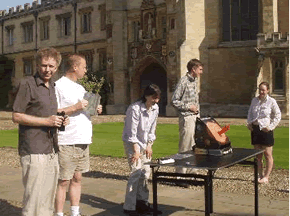Dr Hugh Hunt, a member of the Dynamics and Vibration Group and Fellow of Trinity College, invited Fellows and students at Trinity to come together on Great Court and bring with them various devices for watching the transit of Venus on Tuesday 8 June. All passers by on the day were free to have a look.

The passing of Venus across the face of the Sun is a rare event having last taken place in 1882. There will, however, be another chance to see it in 2012. Although Venus passes between the Earth and the Sun every nineteen months or so, transits are rare because Venus and the Earth orbit the Sun at a slight angle to one another. Viewed from Earth, Venus appears to pass above or below the Sun, rather than across it.
The photos on Hugh's website show some of the means used, and include photos of Sir Martin Rees, the Astronomer Royal watching the event, as well as Hugh's children and cat, Ricardo.
The images seen through the telescope were taken using a 4-inch Meade with solar filter, and a simple digital camera (Olympus C-220 Zoom).
The Pinhole Camera images were produced using a novel design of pinhole camera, devised by Dr Hugh Hunt. The drawback of conventional pinhole cameras is that the size of pinhole required to generate a sharp image is so small that diffraction effects destroy the clarity of the image. The method employed here is to use a large pinhole and to reflect the light through the window of a darkened room, in this case the Old College Office Meeting Room, where a dark cloth was used to blackout the window where the reflected image enters. In fact the "pinhole" was created by blanking out with plastic tape all but a 5mm square portion of a mirror. The pinhole is then simply a tiny mirror.
The remaining images were produced by a Solarscope, being a commercially-available device for safe viewing of the sun and can be viewed at http://www.solarscope.com/en/index.en.html

